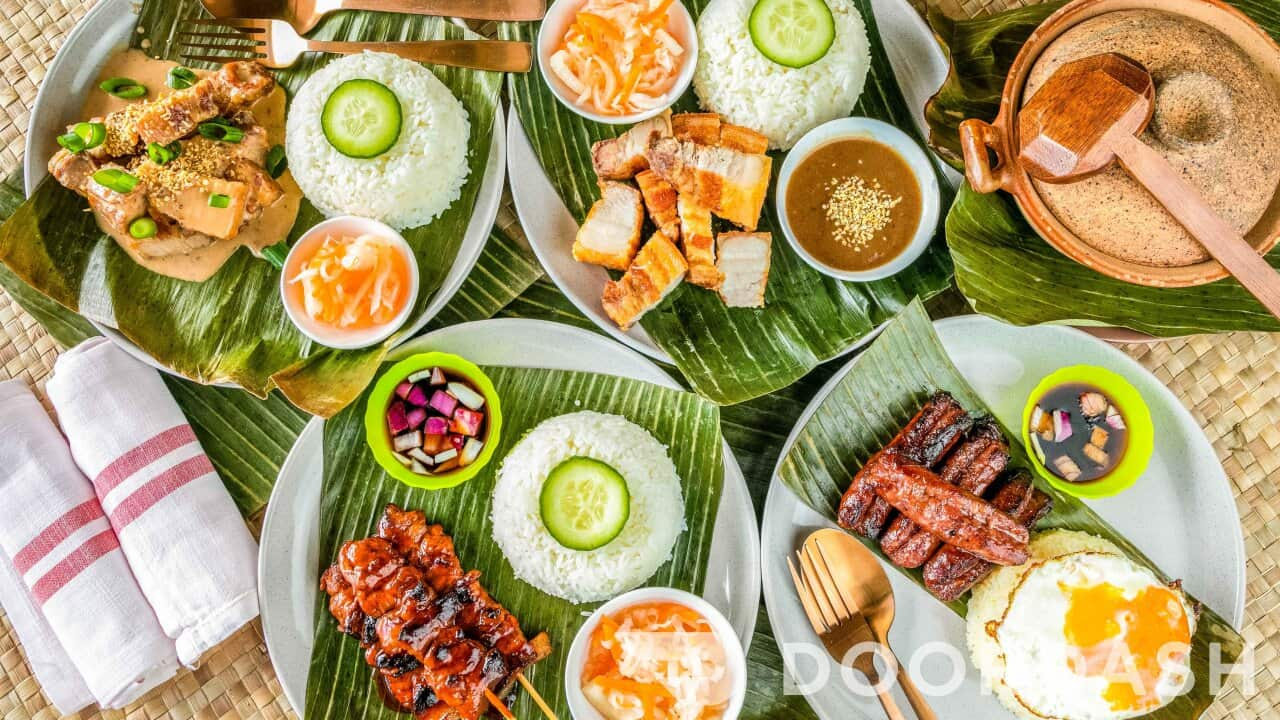The Eurovision Song Contest is back in 2022, held in Turin, Italy! Tune into the Australian exclusive primetime broadcast on SBS and SBS On Demand on 13, 14 and 15 May. For all the details visit , and join the conversation using #SBSEurovision
"My biggest connection to my Filipino background is definitely the food. We had lots of Filipino parties, celebrations and food," , tells SBS Food. "I love Filipino food so much... pancit and adobo and sinigang and all the food is amazing."
Whether you're organising a Eurovision 2022 viewing party or having a karaoke get-together, here are some accompanying Filipino pulutan (food that accompanies drinks) ideas.
We had lots of Filipino parties, celebrations, and food. I love Filipino food so much...pancit and adobo and sinigang.
Remember – the cardinal pulutan rule is to go with "happy food" – that is, fatty and carbo-loaded dishes that sizzle, snap or make your lips pucker.
Send noods
There are an infinite number of pancit (noodle) dishes in the Philippines. Some of the more popular regional varieties include pancit efuven from Iloilo province, which is made of flat noodles; Pancit habhab from Lucban municipality, which is served on banana leaves and eaten without a fork; pancit Malabon from Malabon, featuring seafood gravy and smoked fish; pancit pusit from Cavite province, a seafood vermicelli dish blackened with squid ink, and the saucy pancit luglug from Pampanga province.
But of the many pancit varieties, the most popular are pancit canton with egg noodles and pancit bihon with vermicelli. While they use different noodles, their toppings are similar: typically including vegetables, chicken and/or seafood.
And don't worry – if you're feeling too lazy to cook, you can get instant versions.
How we roll
You know you're at a Filipino party if there's a tray of lumpia or Filipino spring rolls. That's just how we roll! Get it?
Much like pancit, there are many varieties of lumpia, such as the party favourite, lumpiang Shanghai, which has a meat filling. It has a vegetarian cousin, lumpiang togue, with bean sprouts and tofu. Then there's lumpiang sariwa, which has a fresh, soft wrapper and a vegetable filling. The sweet turon, which is filled with bananas and sometimes jackfruit, also deserves a mention.

Lumpia: a childhood favourite. Source: Melissa Fox
Smokin'!
Filipinos love a good barbecue as much as Australians do, but the big difference is that inihaw (grilled food) is typically served with a sauce of soy, vinegar, chilli and calamansi (small Asian lime). From conventional meat and seafood to the overlooked offal and innards, inihaw and marinades differ from region to region, household to household. But the most popular is pork barbecue on a stick, with a piece of fat at the tail end.
From conventional meat and seafood to the overlooked offal and innards, inihaw and marinades differ from region to region, household to household. But the most popular is pork barbecue on a stick, with a piece of fat at the tail end.

Every afternoon, you'll find meat skewers grilled and sold on the streets in the Philippines. Source: Sydney Cebu Lechon
ABOUT INIHAW

Inihaw: Barbecue the Filipino chargrill way
The fat and crispy
Yes, Filipino food can be fatty, oily and unhealthy, but these foods make you realise that sometimes a minute on the lips is worth a lifetime on the hips.
Some of the most popular fatty and crispy pulutan include sisig (a dish made of pork-face parts and belly that's sometimes served on a sizzling plate), lechon or roast pork, lechon kawali or deep-fried pork belly, crispy pata or deep-fried pork hock, chicharon or fried pork rinds, and the even unhealthier version, chicharon bulaklak or deep-fried ruffled fat.

Succulent pork belly stuffed with lemongrass, garlic, salt, pepper and star anise, and slow cooked over charcoal. Source: Sydney Cebu Lechon
The salty and the sour
While some people think Filipino food is all sweet, the truth is, the cuisine is all about balancing really strong flavour profiles.
Vinegar and salt are two ingredients that you'll find in many Filipino dishes.
When it comes to pulutan, the two most popular dishes are tokwa't baboy and kinilaw.
The literal translation of tokwa't baboy is tofu and pork. The dish consists of fried tofu cubes and fried pork bits, served with a mixture of soy sauce, vinegar, onions and chillies.
Kinilaw is Filipino ceviche. Although the most common protein used in kinilaw dishes is fish, it's not unheard of to add grilled meats to the dish.
MORE FILIPINO FOOD

Like sticky rice? You'll love this sticky Filipino rice cake









